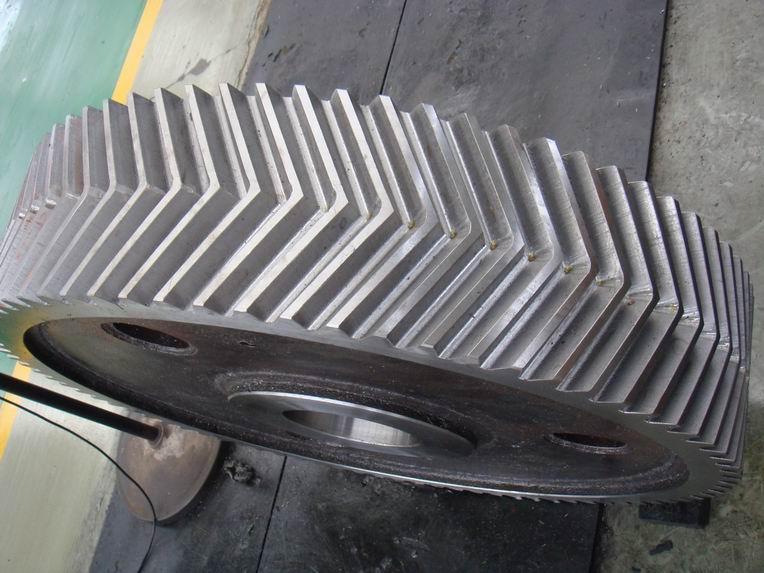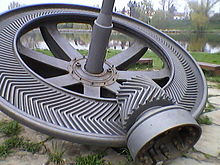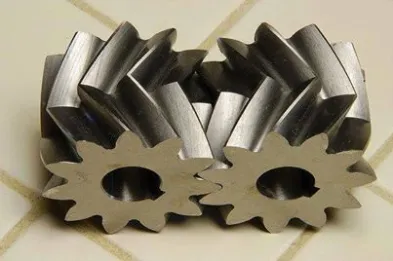Product Description
1) According to the different strength and performance, we choose the steel with strong compression;
2) Using Germany professional software and our professional engineers to design products with more reasonable size and better performance; 3) We can customize our products according to the needs of our customers,Therefore, the optimal performance of the gear can be exerted under different working conditions;
4) Quality assurance in every step to ensure product quality is controllable.
Product Paramenters
| DRIVEN GEAR |
NUMBER OF TEETH |
17 |
|
MODULE |
10.3572 |
|
|
LENTH |
316 |
|
|
OUTER DIAMETER |
ø180 |
|
|
DIRECTION OF SPIRAL |
L |
|
|
ACCURACY OF SPLINE |
M33*1.5-6h |
|
|
NUMBER OF SPLINE |
46 |
|
DRIVEN GEAR |
NUMBER OF TEETH |
28 |
|
OUTER DIAMETER |
ø292 |
|
|
DIAMETER OF INNER HOLE |
ø190 |
|
|
ACCURACY OF SCREW |
16-M16*1.5-6H |
|
|
CENTER DISTANCE OF SCREW HOLE |
ø220 |
|
|
DIRECTION OF SPIRAL |
R |
Company Profiles
Our company,HangZhou CHINAMFG Gear co.,Ltd , specialized in Hypoid and spiral bevel gear used in Automotive industry, was foundeded in 1996, with registered capital 136,8 square meter, with building area of 72,000 square meters. More than 500 employees work in our company.
We own more than 560 high-precise machining equipments, 10 Klingelnberg Oerlikon gear production lines, 36 Gleason gear production lines, 5 forging production lines 2 german Aichilin and 5 CHINAMFG CHINAMFG advanced automatic continuous heat treatment production lines. With the introducing the advanced Oerlikon C50 and P65 measuring center, we enhence our technology level and improve our product quality a lot. We offer better quality and good after-sale service with low price, which insure the good reputation. With the concept of “for the people, by technology, creativity, for the society, transfering friendship, honest”, we are trying to provice the world-top level product.
Our aim is: CHINAMFG Gear,world class, Drive the world.
According to the different strength and performance, we choose the steel with strong compression;Using Germany professional software and our professional engineers to design products with more reasonable size and better performance;We can customize our products according to the needs of our customers,Therefore, the optimal performance of the gear can be exerted under different working conditions;Quality assurance in every step to ensure product quality is controllable.
Our company had full quality management system and had been certified by ISO9001:2000, QS-9000:1998, ISO/TS16949 , which insure the entrance of international market.
Certification & honors
Quality Management
Adopt PDCA for problem solution, to ensure a closed loop.
Packaging & Shipping
Packaging Detail:standard package(carton ,wooden pallet).
Shipping:Support Sea freight. Accept FOB,EXW,FAS,DES.
Cooperative customers
HangZhou CHINAMFG Gear Co., Ltd. adheres to the concept of “people-oriented, prosper with science and technology; create high-quality products, contribute to the society; turn friendship, and contribute sincerely”, and will strive to create world automotive axle spiral bevel gear products.
1.Do you provide samples?
Yes,we can offer free sample but not pay the cost of freight.
2.What about OEM?
Yes,we can do OEM according to your requirements.
3.How about after-sales service?
We have excellent after-sales service if you have any quanlity problem,you can contact us anytime.
4.What about package?
Stardard package or customized package as requirements.
5.How to ensure the quanlity of the products?
We can provide raw meterial report,metallographic examination and the accuracy testing etc.
6.How long is your delivery time?
Genarally it is 4-7 days.If customized it will be take 20 days according to your quantity.
| Application: | Motor, Electric Cars, Motorcycle, Machinery, Marine, Agricultural Machinery, Car |
|---|---|
| Hardness: | Hardened Tooth Surface |
| Gear Position: | External Gear |
| Manufacturing Method: | Cast Gear |
| Toothed Portion Shape: | Herringbone Gear |
| Material: | Cast Steel |
| Samples: |
US$ 80/Set
1 Set(Min.Order) | |
|---|
| Customization: |
Available
| Customized Request |
|---|

What is the purpose of using herringbone gears in machinery?
Using herringbone gears in machinery serves various purposes and offers several advantages. Here’s a detailed explanation of the purposes and benefits of using herringbone gears:
- Smooth and Quiet Operation: Herringbone gears are known for their ability to provide smooth and quiet operation. The double helical tooth design cancels out axial and radial forces, minimizing gear vibrations and reducing noise levels during engagement. This makes herringbone gears suitable for applications where noise reduction and smooth operation are essential, such as precision machinery, automotive transmissions, and gearboxes in industrial equipment.
- High Load Capacity: Herringbone gears have a high load-carrying capacity due to their double helical tooth profile. The opposing helix angles of the gear teeth distribute the load evenly, allowing for efficient power transmission even under heavy loads. This makes herringbone gears suitable for applications that involve high torque requirements and heavy-duty machinery, such as mining equipment, construction machinery, and marine propulsion systems.
- Bidirectional Power Transmission: Herringbone gears can transmit power in both directions without the need for additional thrust bearings or special mechanisms. The double helical tooth profile cancels out axial thrust forces, eliminating the net axial thrust on the gear shaft. This bidirectional power transmission capability makes herringbone gears suitable for applications where reversible power transfer is required, such as marine propulsion systems, locomotives, and machine tools.
- High-Speed Applications: Herringbone gears are well-suited for high-speed applications due to their enhanced tooth strength and efficient torque transfer. The double helical tooth design provides increased tooth contact area and improved load distribution, allowing for reliable power transmission at high rotational speeds. This makes herringbone gears suitable for applications such as turbo machinery, power generation equipment, and high-speed gearboxes.
- Reduced Wear and Improved Durability: The double helical tooth profile of herringbone gears helps to minimize wear and improve gear durability. The opposing helix angles distribute the load evenly across the gear teeth, reducing localized stress concentrations and minimizing the risk of tooth failure. This ensures long service life and reliable operation, making herringbone gears suitable for applications where durability and longevity are critical, such as heavy machinery, industrial equipment, and wind turbine systems.
- Efficient Power Transmission: Herringbone gears offer efficient power transmission due to their large contact area and overlapping tooth engagement. The double helical tooth profile provides a larger contact ratio compared to spur gears, allowing for a greater number of teeth in contact at any given time. This efficient torque transfer minimizes power losses and improves overall gear system efficiency, making herringbone gears suitable for applications where energy efficiency is a priority, such as automotive transmissions, gearboxes, and power transmission systems.
The purpose of using herringbone gears in machinery is to achieve smooth and quiet operation, handle high loads, enable bidirectional power transmission, accommodate high-speed applications, ensure durability and longevity, and achieve efficient power transmission. These advantages make herringbone gears a preferred choice in various industries and applications where reliable and high-performance gearing solutions are required.

How do you maintain and service a herringbone gear system?
Maintaining and servicing a herringbone gear system is crucial for ensuring its optimal performance, longevity, and reliability. Regular maintenance and service activities help identify and address potential issues, minimize wear, and extend the lifespan of the gear system. Here’s a detailed explanation of how to maintain and service a herringbone gear system:
- Inspection: Conduct regular visual inspections of the gear system to identify any signs of wear, damage, or misalignment. Inspect the gear teeth, shafts, bearings, and other components for any visible abnormalities, such as pitting, scoring, cracks, or excessive wear. Check for oil leaks, loose fasteners, or any other potential issues that may affect the gear system’s performance.
- Lubrication: Ensure that the lubrication of the herringbone gear system is adequate and meets the manufacturer’s recommendations. Monitor the lubricant level and condition regularly. Check for proper lubricant distribution and coverage on the gear teeth and contact surfaces. Replenish or replace the lubricant as necessary to maintain the required film thickness and lubricating properties.
- Alignment and Clearance: Check and maintain proper shaft alignment to prevent misalignment-related issues. Use alignment tools such as dial indicators or laser alignment systems to verify the parallelism and concentricity of the gear system shafts. Ensure that the gear engagement is correct and that there is appropriate gear backlash. Make any necessary adjustments to optimize gear alignment and clearance as per the manufacturer’s guidelines.
- Fasteners and Connections: Regularly inspect and tighten all fasteners, such as bolts, set screws, or clamps, to ensure that they are securely fastened. Loose fasteners can lead to misalignment, vibration, and potential gear system failure. Follow the recommended torque specifications provided by the manufacturer when tightening the fasteners to avoid over-tightening or under-tightening.
- Monitoring and Analysis: Implement a monitoring and analysis program to track the performance of the herringbone gear system over time. This can include vibration analysis, temperature monitoring, and oil analysis. These techniques can help identify any abnormal conditions, such as excessive vibration, increased temperatures, or the presence of contaminants or wear particles in the lubricant. Regular analysis and monitoring can aid in detecting potential issues early and taking appropriate corrective actions.
- Repair and Replacement: If any signs of wear, damage, or abnormal conditions are detected during inspections or monitoring, take prompt action to address the issues. Depending on the severity of the problem, this may involve repairing or replacing worn or damaged components, such as gear teeth, bearings, or seals. Follow the manufacturer’s guidelines and consult with qualified technicians or professionals for any necessary repair or replacement procedures.
- Documentation and Record-keeping: Maintain accurate documentation and records of all maintenance and service activities performed on the herringbone gear system. This includes inspection reports, lubrication records, repair or replacement history, and any other relevant information. These records can serve as a reference for future maintenance, help track the gear system’s performance, and aid in troubleshooting or warranty claims if needed.
It is important to note that the specific maintenance and service requirements may vary depending on the gear system design, application, and operating conditions. Always refer to the manufacturer’s guidelines, technical documentation, and any applicable industry standards for the recommended maintenance practices and service intervals specific to your herringbone gear system.

Can you explain the unique shape of herringbone gear teeth?
The unique shape of herringbone gear teeth is a defining characteristic of herringbone gears, also known as double helical gears. Here’s a detailed explanation of the unique shape of herringbone gear teeth:
Herringbone gears have a V-shaped or herringbone-shaped tooth profile, which is formed by two helical gear sections that are mirror images of each other. This tooth profile is distinct from the straight or helical tooth profiles found in other types of gears such as spur gears or helical gears.
When viewed from the end, the teeth of a herringbone gear resemble the letter “V”. This shape is created by the combination of two opposing helix angles, one on each side of the gear. The helix angle refers to the angle at which the teeth are inclined relative to the gear’s axis.
In a herringbone gear, the helix angle of one helical section is opposite in direction to the helix angle of the other helical section. This means that as the gear rotates, the teeth on one side lean in one direction, while the teeth on the other side lean in the opposite direction.
The opposing helix angles of the two gear sections in herringbone gears serve several important purposes:
- Axial Thrust Elimination: One of the main advantages of the herringbone gear design is the elimination of axial thrust or end thrust forces. In helical gears, the helix angle of the teeth generates an axial force along the gear’s axis during rotation. However, in herringbone gears, the opposing helix angles cancel out these axial forces, resulting in a balanced gear that does not experience significant axial movement or require thrust bearings.
- Smooth Engagement: The opposing helix angles of herringbone gears facilitate smooth and gradual tooth engagement. As the gear rotates, the teeth on one side gradually come into contact with the teeth on the other side. This gradual meshing reduces sliding friction, minimizes backlash, and ensures a continuous and smooth transfer of power between the gear sections.
- Increased Load Capacity: The V-shaped tooth profile of herringbone gears provides increased tooth contact area compared to gears with straight or helical teeth. This increased contact area improves load distribution and allows herringbone gears to handle higher torque loads, resulting in an increased load-carrying capacity.
The unique shape of herringbone gear teeth requires precise manufacturing techniques to ensure proper meshing and alignment of the gear sections. The teeth must be accurately machined to achieve the correct helix angles and tooth profiles, ensuring smooth operation and efficient power transmission.
In summary, the unique shape of herringbone gear teeth, with their V-shaped or herringbone-shaped profile formed by opposing helix angles, enables axial thrust elimination, smooth engagement, and increased load capacity. These characteristics make herringbone gears well-suited for applications where efficient torque transmission, balanced operation, and high load-carrying capacity are essential.


editor by CX 2023-10-12